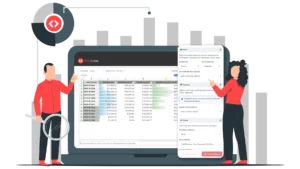Updated: April 12, 2024
Understanding fees is paramount for success in the fast-paced world of short-term rentals. In our April Masterclass, we were joined by a diverse panel of speakers who came together to discuss and debate the intricacies of the so-called “junk” fees. Focusing on practical strategies and industry insights, the session delves into the complexities of short-term rental fees and uncovers actionable insights to propel your rental business forward.
In this rich and diverse conversation, Host Thibault Masson, Head of Product Marketing at PriceLabs and Founder of Rental Scale-Up, talks with industry experts:
- Aiden Groll, Co-founder, Blue Gems Property Management
- Tim Speicher, Revenue Manager at Buoy
- Monique DeLorenzo, Solutions Consultant, PriceLabs
The panel shared a variety of insightful viewpoints, drawing from real-world experiences to offer practical advice for large property and revenue managers.
Session Highlights
- The place of fees in a property management company’s P&L
- How are fees calculated? Review of common fees.
- How does Airbnb’s total price display affect fee strategies?
- What are the pros and cons of rolling the fees into your nightly rate?
- PriceLabs, PMSs, Channels & Fees: Where to insert fees?
Watch the replay on YouTube
About the speakers
Tim Speicher is a seasoned professional with diverse industry experience. He Co-founded Buoy, a company that focuses on vacation rental pricing.
Monique DeLorenzo currently wears two hats—a Solutions Consultant at PriceLabs and a successful Vermont a-frame property owner.Her firsthand hosting experience enables her to offer practical advice and strategic solutions to clients navigating the short-term rental industry.
Aidan Groll, a dynamic entrepreneur, co-founded Blue Gems MGMT, a property management firm. With experience from Verizon and other roles, plus a finance degree from Caldwell University, Aidan specializes in Airbnb investments, and management of short-term rental portfolios. You can catch him co-hosting the popular Blue Gems Podcast along with co-founder JB Bullock.
What’s the share of fees in total revenues, and how does your company approach fee allocation in response to market dynamics?
Aiden revealed that approximately 20% of his company’s total revenues are allocated to fees, primarily consisting of cleaning fees and other charges. He highlighted the need to adapt fee strategies to retain inventory and navigate the increasingly competitive Orlando market, showcasing a commitment to achieving optimal net margins while delivering exceptional guest experiences.
Tim discussed the variability in fee percentages depending on factors such as property type and location, stressing the importance of aligning fee structures with operational costs and guest expectations. He emphasized the need to justify fees based on operational necessities rather than purely profit-driven motives, advocating for a guest-centric approach that minimizes guest discomfort while ensuring competitive pricing.
Monique threw light on the challenges of quantifying fee percentages, mentioning the wide-ranging practices among property management businesses that she helps. She underscored the impact of organizational maturity and cultural orientation on fee strategies, noting the stark difference between traditional and contemporary approaches to fees. She, too, emphasized the need for property managers to consider guest perception and brand image when designing fee structures, reflecting a nuanced understanding of the multifaceted role fees play in shaping the guest experience and overall business success.
How are fees calculated, and what factors influence your approach to fee allocation in response to market dynamics?
Tim elaborated on the intricacies of fee calculation, drawing from his experience managing properties in the Bay area. He recounted the challenges of balancing fees with operational costs, particularly in highly competitive markets where even slight fee adjustments could impact guest perception and competitiveness. He emphasized the importance of aligning fees with operational realities while remaining mindful of guest expectations and market competition, showcasing a pragmatic approach to fee management tailored to specific market conditions.
Aidan echoed Tim’s sentiments, emphasizing the significance of considering operational profitability when calculating fees. He highlighted the nuanced approach his company adopts, taking into account not only the total vacation cost but also the competitive landscape, including alternative accommodations like those offered by Disney. Aidan emphasized the need for flexibility in fee strategies, particularly in adapting to seasonal fluctuations and aligning fee structures with broader business objectives, reflecting a strategic and adaptive approach to fee management aimed at maximizing overall business performance.
Monique provided a broader perspective on fee calculation, drawing from her observations across various property management businesses. She noted a trend towards integrating fees into nightly operational costs rather than presenting them as separate line items, reflecting a shift towards a more transparent and guest-friendly approach. Monique also highlighted the seasonality of fee strategies, with property managers adjusting fee structures based on peak and off-peak demand periods to optimize occupancy and competitiveness. Her insights underscored the evolving nature of fee management practices and the importance of agility in responding to market dynamics while prioritizing guest satisfaction and business performance.








